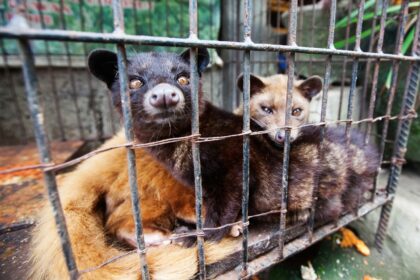In his 2012 book An Introduction to Animals in Visual Culture, author Randy Malamud clearly states his beliefs about the ethical concerns zoos raise:
The zoo experience is voyeuristic, imperialistic, inauthentic, and steeped in the ethos of consumer culture, which is antithetical to nature and ecology, and hence a danger to animals. The animals do not belong there. They cannot possibly be happy there, which negates the possibility that a zoo visit can be an educational experience […] Zoos contain sad animals, constrained animals, displaced animals, but zoo spectators are induced to sublimate this, and pretend they are looking at real animals (115).
As someone who has fond memories of field trips and family trips to Zoo Atlanta and the lesser-known Yellow River Game Ranch, his unflinching opinions were initially tough pills to swallow — but also hard to ignore. While I can’t say those trips to the zoo left me feeling uncomfortable — on the contrary, I always had a great time, and as a nanny I loved watching my kids get excited about flamingos, lions and baby gorillas — thinking about the ethical implications of zoos certainly does.

For those who are maybe not willing to give up on visiting zoos altogether, how can one enjoy and feel a sense of wonder in the presence of animals in a responsible, ethical way?
Here are a few key questions and answers for the curious traveler and zoo-goer:
What distinguishes a responsible zoo from one that’s irresponsible?
According the Clare Hancock of Immersion Travel Magazine, the key is whether or not a zoo is “working to conserve the environment; rescue, rehabilitate and release animals that have been injured and can be successfully released; provide a safe haven for animals that cannot be released back into the wild; and work[ing] diligently to educate the public about protecting the environment.”
Another distinction, she notes, is how and why the animals were acquired. A responsible zoo is one that gets their animals from unfortunate circumstances, rescues them from life-threatening situations in the wild or unnatural domestic environments, and provides homes for animals that were a result of over-breeding at other facilities.
Further, Adam M. Roberts, CEO of Born Free USA and the Born Free Foundation, says that a responsible zoo is one that provides a home for animals in need and “does not breed, import from the wild, commercially trade in or remove animals from the premises, or have animal performances or public contact.”
The key, it seems, is keeping nuanced distinctions in mind, as Sarah Bareham, marketing executive at Responsible Travel, points out:
“We do recognize that some captive facilities play a valuable role in the conservation of endangered species, and the rescue and rehabilitation of wild animals; however, not all are as worthy as they sound. Sanctuaries, animal rescue centers and the like, which offer the opportunity for human interaction with the animals, walking with lions, elephant rides or photo props for example, or which encourage unnatural behavior. For example dolphin shows, orca shows and elephant orchestras are likely to have profits, rather than real conservation aims at heart.”
What responsibility does the traveler have when visiting animals in captivity?
The foremost responsibility travelers have is to do their homework. Luckily, there are ample resources available to consult before patronizing a potentially unethical zoo or sanctuary. Hancock says that travelers need to ask the right questions:
- How are the animals acquired?
- What kinds of education programs have been implemented?
- What kinds of enrichment do the animals receive, and how often?
- Do the enclosures resemble the natural habitats of the animals housed in them, and are they spacious enough?
- Are the animals looked at as individuals within the facility (not just another tiger or dolphin or tarantula)?

Beyond this, travelers must think critically about what an organization does, not just what it claims to do. Hancock advises not judging a place by what it calls itself and instead advises trying to understand what the organization’s genuine interests are. Not-for-profits that use profits for research, rescue and education projects are a good place to start.
Bareham recommends a number of travel guides that can make researching and answering these questions quick and easy, including Responsible Travel’s own guides, Care for the Wild’s Right Tourism campaign, World Animal Protection’s Animal Friendly Tourism Guide and Bemused Backpacker’s guide to zoos as part of responsible tourism.
Finally, travelers can and should report unethical attractions and instances of abuse. Roberts recommends reporting to Born Free itself, as the organization aims to “investigate and expose malpractice in exploitative animal entertainment and advocate for change at all levels of government in the regulations governing the keeping of animals in captivity” and “rescue and re-home animals from poor captive situations to humane lifetime care.”
What are some responsible wildlife alternatives to zoos?
The best alternative, these experts recommend, is seeing animals in their natural habitat, from responsible safaris to whale-watching excursions. Roberts says some good options are those accredited by the Global Federation of Animal Sanctuaries, as is nature-based tourism that doesn’t involve animal captivity, like visiting state or national parks.
Hancock and Bareham cite specific examples of remarkable, ethical zoos and organizations, including the Heritage Park Zoological Sanctuary in Prescott, Arizona and the award-winning South African Animal Sanctuary Alliance.

Seeking opportunities to witness and share space with animals in their natural habitat, Bareham argues, is a much more moving experience, too.
To witness an animal in captivity, Malamud says, is deceptive:
The visual cultural experience is meant (by the institutional power structure of zoos and civic cultural organizations at large) to reassure audiences that seeing these animals suggests that all is well: seeing is believing. But what we are seeing is a sham, a deception (120).
Ultimately, then, it is up to the responsible traveler to shift their focus from the convenient, from the profit-driven, and from the exploitative to something authentic, philanthropic, and with the animals’ best interests in mind.
Recommended Reads:
Wildlife Management and Conservation: Contemporary Principles and Practices by Paul R. Krausman
Overbooked: The Exploding Business of Travel and Tourism by Elizabeth Becker
Vagabonding: An Uncommon Guide to the Art of Long-Term World Travel by Rolf Potts
Have you ever visited an ethical or unethical zoo or animal sanctuary? Please share in the comments below.
Also Check Out:
How Give Back Yoga Is Providing Health To Communities In Need & The World
How Small Actions When Traveling Have A Big Impact On Children
Latest posts by Paige Sullivan (see all)
- Holiday Treats & Christmas Traditions Around The World - Dec 19, 2016
- Handouts In Developed Nations: Advice For The Responsible Traveler - Jun 7, 2016
- 5 Immersive Culinary Enclaves To Savor In NYC - Feb 18, 2016
- Traveling Responsibly & Protecting Fragile Environments - Jan 9, 2016
- Can Tiger Tourism Be Responsible? - Jan 9, 2016





